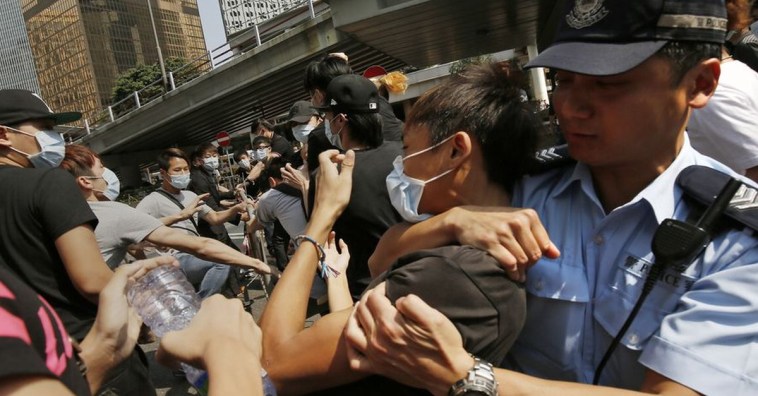HONG KONG — An angry crowd opposed to pro-democracy protests that have paralyzed parts of Hong Kong for more than two weeks charged barricades used by the demonstrators on Monday, clashing with police as they attempted to storm the protest zone.
Videos By Rare
Scuffles broke out as about two dozen men wearing surgical masks to hide their faces tried to forcefully remove the metal barricades that protesters have set up to block off main roads near the heart of Hong Kong’s financial district. Some were seen using box cutters to snap cables connecting the barricades.
Several hundred of the protesters’ rivals rushed up to the barricades, punching their fists in the air and chanting “Open the road!” They also shouted “Occupy Central is illegal,” referring to one of the names of the pro-democracy movement that has swept Hong Kong.
Taxi drivers joined in, some driving their cabs up to the barricades and leaning on their horns to express their anger about the traffic disruptions.
A line of police officers held the crowd back, keeping them separated from the protesters on the other side of the barriers.
Protester Alex Kwok said he received a scratch on his arm after he was attacked by several men whom he accused of being members of triads, or organized crime gangs.
The tension later eased as the most of the crowd dispersed. Police took away some masked men inside the protest zone who tried to pick fights with the protesters, and later said they arrested three men, aged 18 to 47, at the clashes on suspicion of assault and carrying weapons.
It was not immediately clear who convened the anti-protest crowd.
“Before the police came, young men wearing masks and dark clothing came to pick fights with people and we heard that some of them had weapons,” said Kevin Ng, a college student who was at the scene and saw the scuffles. “I don’t know who the young men wearing masks were. We suspect they’re triad members, but it’s hard to say. What other kind of group would organize themselves to come attack us?”
Allegations have surfaced in the past few weeks that some people were paid to disrupt the protests. A local radio station broadcast an audio clip Monday in which a man, said to be a taxi driver, discussed a payment of 2,000 Hong Kong dollars ($258) to take part in the ruckus.
The clip cannot be independently verified and it was not clear where the alleged payment was coming from.
Demonstrators have flooded Hong Kong’s streets since Sept. 28 in a civil disobedience movement opposing restrictions on the first-ever direct election for the semiautonomous Chinese city’s leader, promised by Beijing for 2017. They want authorities to drop a plan to use a pro-Beijing committee to screen candidates in the election.
They also want Chief Executive Leung Chun-ying, the city’s Beijing-backed leader, to resign.
Speaking to reporters at an event in Guangzhou, a city in southern China, Leung stressed that the authorities have handled the protests with a “huge degree of tolerance.” He dodged a question about when officers will move in to clear the protests, saying only, “We cannot let this situation continue in the long term.”
Leung also said, “I will not resign, and I don’t have to resign.”
Earlier Monday, police removed some barricades on the edges of the protest zone to allow some traffic through the area.
Police stressed that the operation — carried out at dawn, when the number of protesters at the site is typically at its lowest — was not meant to clear the area, and said it was only to relieve traffic congestion for commuters heading to work.
Police spokesman Steve Hui said later Monday that officers would continue to trim the protest zone, and warned that anyone challenging them could be arrested.
Tens of thousands of protesters have occupied busy roads outside the city government headquarters as well as in two busy shopping districts elsewhere in Hong Kong to press their demands, but their numbers have since dwindled.
Associated Press writer Joanna Chiu contributed to this report.
Copyright The Associated Press

